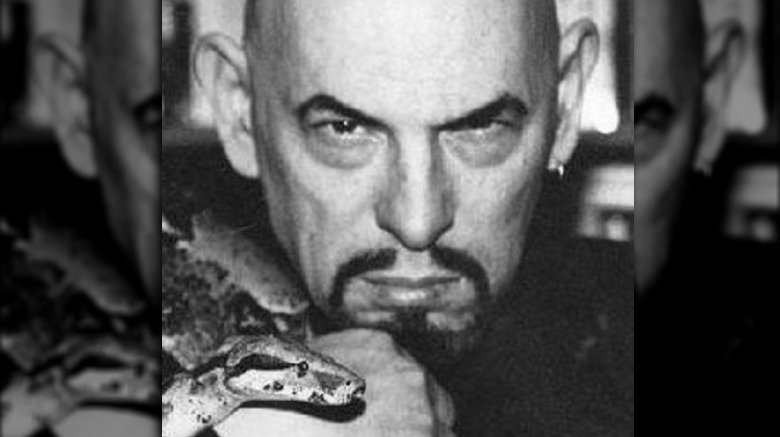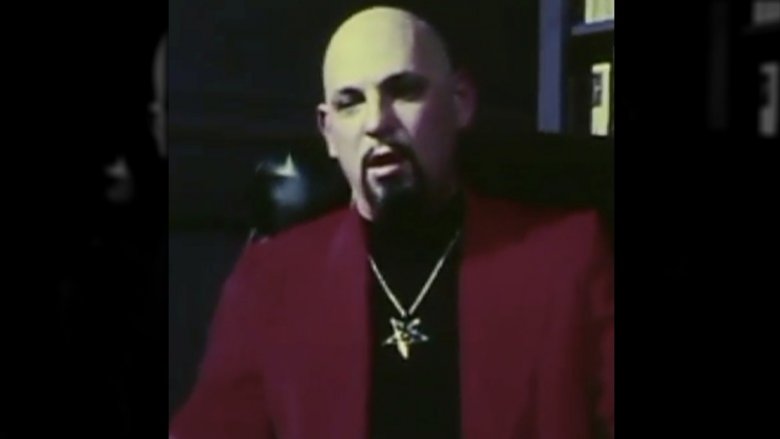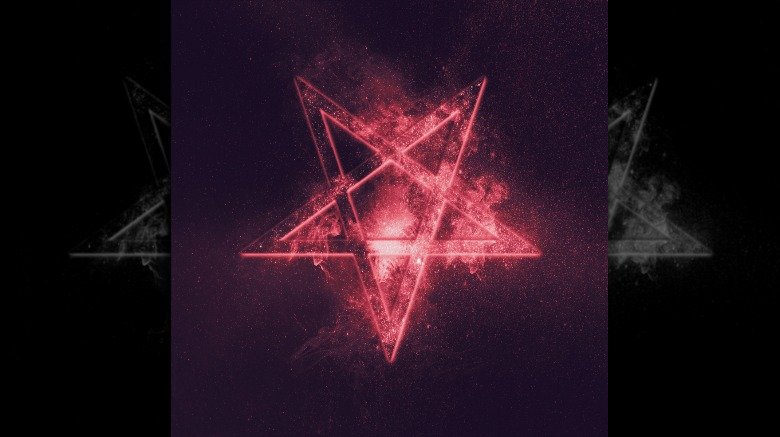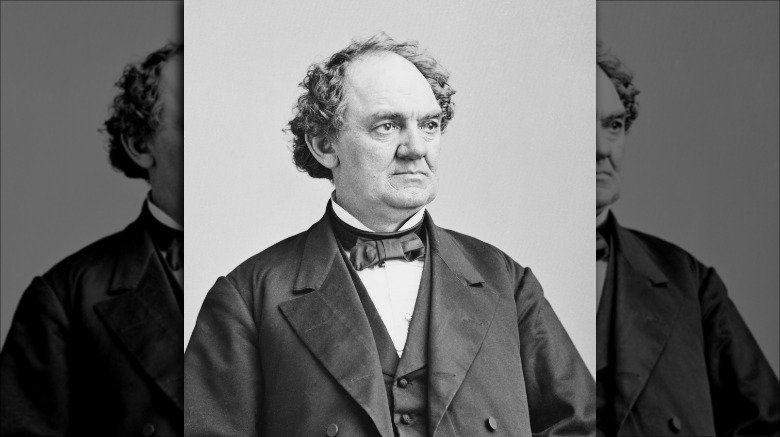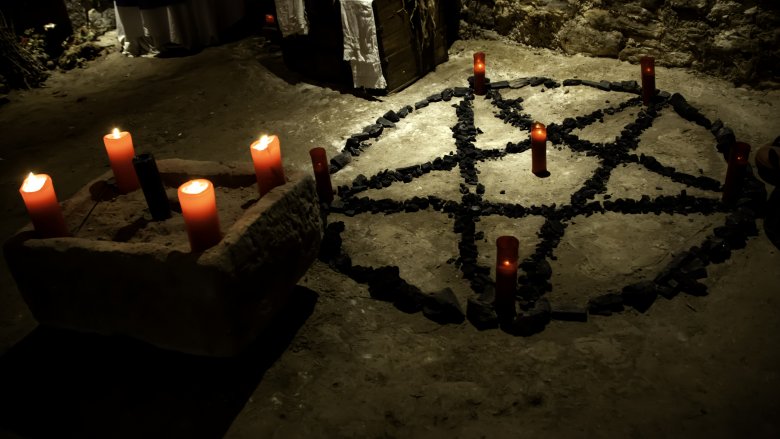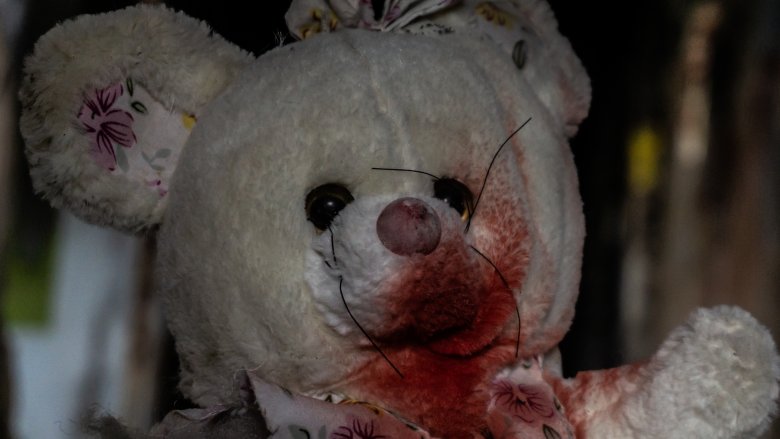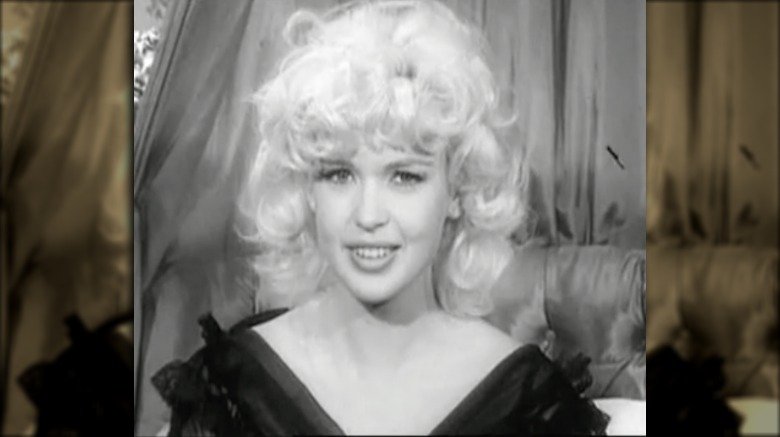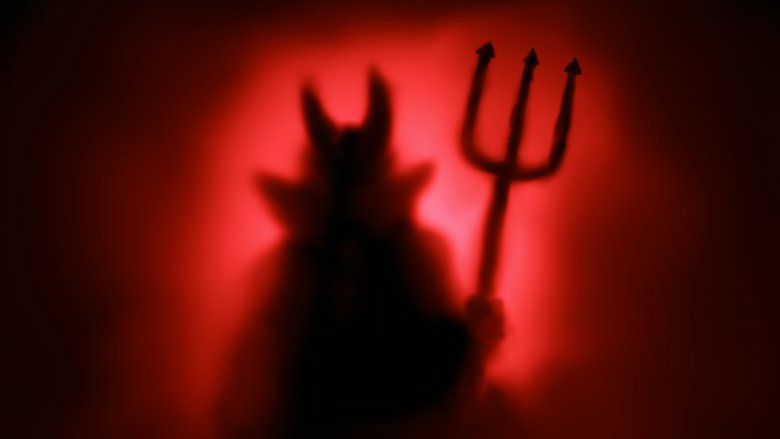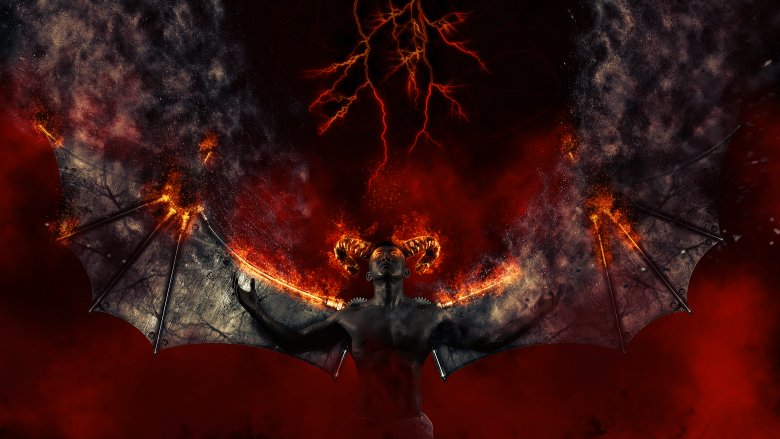Anton LaVey: The Truth About The Church Of Satan Founder
There are many different kinds of evil. Of course, you've got your just plain nasty black-on-black evil, like serial killers and tacky gold-chain wearing despots. Then you've got crazy evil (eating a firefly) and senseless evil (axing Firefly). And of course, let's not forget that there's a whole library of lesser quasi-evils: mildly foul deeds of infamy like sticking gum under public library desks or sneaking almond milk into an innocent person's coffee.
All these evils are, well, fine. But arguably the best kind of evil is the one you pronounce "eeeevillll," while stroking a python lazily curled around your shoulders. We're talking flamboyant, silly evil. This is the exact flavor of evil exemplified by one Anton LaVey, founder of the Church of Satan, wearer of plastic devil horns, and master of cheesy circus music. Come then, if you dare. Let us delve into the mystical life and times of one of the great Satanists of our age: Howard Stanton Levey, aka Anton LaVey.
Who was Anton LaVey?
Anton LaVey (as mentioned, originally Howard Stanton Levey) was born in 1930. Raised in suburban SanFrancisco, LaVey had a conventional upbringing. His parents were non-religious, and nothing about his early years marked him as a dude destined for demonic dastardliness. By the mid-sixties, LaVey had a cozy little set up as the charismatic leader of the Church of Satan. Partly a cult, part an intellectual movement, the Church of Satan made LaVey (who later was dubbed the Black Pope) culturally infamous right through to his death in 1997.
So, who was this guy? Well, in an interview with LaVey at the height of his Satanic grooviness (pictured), the first thing you think is that this is a person you'd probably notice if he was standing in the same line as you at Walgreens. He was tall(ish), at six feet, and something about his lean physique and gleaming, bald head gave him a flamboyantly sinister aspect.
The interview also reveals that he was devilishly pretentious. Affectation came easily to LaVey, but something about his slow delivery, his circuitous sentences, his intense gaze, gave him an odd air of gravitas. Few people in history have been able to wear plastic devil horns and a black satin cape without inviting universal ridicule. Anton (sometimes) came close to pulling it off.
Anton LaVey lied ... really, a lot
In polite terms, LaVey was a storyteller. In less polite terms, the man was a pathological liar. Throughout his life, LaVey wove a thick layer of deception about him. As compiled on the Church of Satan's website, LaVey gave many different accounts of his journey to the Dark Lord's scratchy embrace. In one story, he realized the fundamental evil of humanity when he was working as a murder scene photographer in San Francisco in the 1950s. In another, he claimed he was introduced to Beelzebub and all his hellacious minions by his Transylvanian Romani grandmother. And these are just the tip of the pants-on-fire iceberg. We know for definite that his claims of having been a lion tamer and a crime photographer are completely false. At the same time, it's on the public record that he was a professional organist, a historian savant, and that he made a good living for a time as a "paranormal investigator."
So it's difficult to separate truth from fiction with LaVey, but we know he sat on a great big throne of lies and the vast majority of his claims about his personal history were likely heavily truth-challenged. LaVey himself said: "I'm one helluva liar. Most of my adult life, I've been accused of being a charlatan, a phony, an impostor. I guess that makes me about as close to what the Devil's supposed to be as anyone ... I lie constantly, incessantly." Good point. Well made.
Let's take a closer look at Anton LaVey's Satanism
Let's get the big, infernal elephant in the room out the way first: LaVey never claimed to believe in Satan — at least not in the sense one might imagine. To LaVey, Satan was more a symbol and metaphor than a distressingly sulfurous chap in provocative red tights. In LaVey's words, "I mean Satanic in the sense of a philosophical concept, a realm, or a state of being that would best be described as a lifestyle, an outlook, an attitude."
It's hard not to find this version of Satan,well, boring. But the depressingly mundane truth is that LaVey's version of Satanism was more Evil-Lite (TM) than true infernal intent. More than anything else, LaVeyan Satanism seems to have been a fun diversion for folks with a penchant for amateur dramatics. As he matured, LaVey's version of Satanism fleshed out and gained more depth. He began to flirt with the idea that his Satanic movement offered enlightened people (mostly atheists) a way to "fill the gap between religion and psychiatry." LaVeyan Satanism is described as "exultation of self." It's not built on a desire to destroy all that's good, and to inflict chaos on the world. It's just a way to reconcile an enlightened skeptical worldview with potent fantasy and symbolism. Put another way, he wanted to offer non-religious folks a way of feeling religious. Clearly, he hadn't discovered barbecue flavored cheesy snacks.
Anton LaVey's inspirations are a big reveal
Let's take a step away from his big, serious Church of Satan endeavors to look at the young Anton's early influences. LaVey undoubtedly walked in the footsteps of Aleister Crowley, an acclaimed occultist and scallawag in his own right. Much of his aesthetic and esoteric lingo pays homage to Crowley's mystical dramatics. Patheos says he also references Ayn Rand, an anarchist libertarian intellectual who reviled faith and superstition in all forms. Crowley advocated extreme mysticism. Rand proclaimed unflinching humanism. Either philosophical influence in isolation might create a passionate and single-minded person, but how can they possibly be combined?
The unusual psychological glue adhering these two fundamentally incompatible life paradigms may well have been LaVey's early fascination with the circus and the life of trickster extraordinaire, PT Barnum. Barnum was a gifted marketer, self-promoter, and is widely regarded as the patron saint of scammers, grifters and silver-tongued bedevilment of all stripes. It seems as good a theory as any, and if that is the case, perhaps LaVey simply stumbled into Satanism in an attempt to reconcile the mismatched pursuits of mystical escapism, objective truth-seeking, and the joys of trickery.
How did he capture so many hearts and minds?
To set the scene, a quick recap: It's 1966. LaVey's serious church of nastiness is growing by the day. There's a growing body of beliefs. People are beginning to take it seriously. And behind it all we have this confused drama-boi wearing a black cape. How did one highly weird individual manage to convert such schlock ingredients into a movement with lasting cultural momentum?
LaVey was a specific kind of historian. He studied ritual obsessively. Reading between the lines of his interviews, he was far more interested in what these mystical movements did than what they believed in. In one interview he said: "Ritual represents the freeing of all intellectual thought and the opportunity to bring out the emotions ... It's a chance to be without hangups at all for a time, and really let what you feel inside come out."
LaVey knew how to rev people up with ritual, and it gained him both infamy and admiration. As one example, in 1967, LaVey sent out a press release for the "first Satanic baptism in history." The press lapped it up. And when you get down to it, this is why people are still talking about LaVey. It wasn't his natty dress sense. It wasn't his name-dropping the Prince Of Darkness. It certainly wasn't his ideas. It was his knack for bringing all this together into groovy rituals that made people stop and stare. He was a savant of symbolism.
Anton LaVey was also a great big, bald cornball
There's also something just deliciously corny about Anton LaVey, and it's hard to believe that he wasn't happily aware of it. As exhibit A, his ... errrm... music. Including his delightful Satanic Mass album. If anyone could listen to all of it in one sitting they are definitely one of Satan's little treasures. Basically, his attempt at being a rock star combines the spectacle of that lean figure, that perfectly bald gleaming head, that immaculate nasty-person goatee, with a guy with a Wurlitzer playing circus carnival music. It's hard to reconcile this with the authority needed to be secretary of a PTA meeting, let alone the infernal Church of Satan.
The point is, sure, there's depth to this guy. He had meaningful things to say and maybe he was even successful at holding a mirror up to society's self-important religiosity at the time. He was also just a great big nutball nerdmeister having fun as the ringleader of his own personal freak show. This willingness to have fun with his fame makes Anton LaVey so much more interesting than his Church or the people who followed eagerly in his wake to cash in on the Satan mystique. There's an air of the embittered, cruel circus ringmaster about LaVey. But all the while, he's smirking at himself and the audience who are watching. He's fun.
But don't laugh too loudly...
While there's a lot of absurdity to LaVey's self-indulgent forays into pop mysticism, some of his beliefs became downright ominous — and not in a cool, "hail Satan" way. In his written work and interview statements, LaVey frequently pays intellectual homage to social Darwinism, specifically the belief that superior cultures would rise to the top while inferior ones would (and should) sink into obscurity.
This is where it gets a bit complex though. It's doubtful that LaVey was a particularly hateful or racist person. Nevertheless, through this "survival of the fittest" rhetoric, over the years The Church of Satan has attracted a white supremacist following. The Church of Satan's official line is that it is an apolitical organization, and throughout social media you'll find threads of arguments pushing accusations and counter-accusations of bigotry and fascist leanings back and forth.
One insight into a possible internal rift over this issue can be found in an article on the anti-fascism website It's Going Down. The article points out that while the church may not officially condone fascism, it nevertheless has a permissive stance to pro-fascism content on its website. Intriguingly, both its links to examples are now dead links. Regardless of whether these articles were taken down due to public pressure or internal divisions or just technical issues, LaVey's ideas strongly resonate with white supremacist viewpoints, and his name is spoken with reverence by more than a few white supremacists today.
The Jayne Mansfield affair
By now we have a conflicting image of LaVey. He's an eccentric grifter who harbors some pretty intense ideas. But where's his spooky occultism? That part of his story hit its peak with The Jayne Mansfield Affair.
One of the most speculated and debated aspects of LaVey's life was his odd relationship with blonde bombshell actress Jayne Mansfield. The pair started to appear in the press in 1966. It was unclear whether they were "an item" (to use the lingo of the day), but whether they were BFFs or FWBs, an odd intimacy is undeniable in their pictures. In one famous picture, Mansfield is smiling a vacuous "Monroe-esque" smile, while LaVey looms over her like an emaciated and mildly amorous Uncle Fester.
Sometime in 1967 their highly publicized relationship went south. Mansfield's then boyfriend, Sam Brody, is believed to have disliked LaVey's growing influence over Mansfield. Vanity Fair says the conflict escalated sharply, with LaVey allegedly cursing Brody — as one does when one is in league with Satan and feeling a bit miffed — claiming he was doomed to die in a car accident. LaVey's hex was successful. Both were involved in a fatal car accident and died instantly. Crazy coincidence? Sure. But it made people wonder if he had real power. And as his notoriety increased, LaVey doubled down on that cred. Mess with LaVey and bad things might happen to you.
Anton LaVey, the pop-culture symbol
SF Gate reported Anton LaVey died of a pulmonary edema in 1997. He was 67-years-old. But even without the cartoony frontman, his cultural influence lived on.
After death, his persona still refuses to be just one thing. He's an amorphous shadow, simultaneously devilishly cool with his smirk of knowing command, and impossibly clunky as he plunks out fairground tunes on his beloved Wurlitzer. Like the man himself, his pop-culture notoriety is filled with paradoxes. LaVey is lumped in with the same rebellious anti-authority coolness which drove rock and metal music, but he disliked both. Despite exuding an aesthetic of surreal excess and hedonism, LaVey was deeply opposed to drug use his whole life. He's just not a guy you can easily get a bead on.
LaVey is the Schrodinger's Cat of cultural icons. He defies description. He made Satanism pedestrian. He made humanism sexy. He welded circus carnival macabre with an eclectic blend of German expressionism, B-grade horror dramatics and a Frankensteinian fusion of Western philosophical schools. The result: something as gloriously ominous as it was unapologetically banal. He was, according to LA Weekly, Satanism's beloved Black Pope.
What happened to Anton LaVey's devilishness?
Sadly, outside of his pop-culture significance, LaVey's legacy is notably lackluster. In 1985, his daughter Zeena took her father's mantle and became the High Priestess of the Church of Satan. But Zeena was not her father. She had the same shtick, but none of the charisma which wrapped his father's ideas up into such a compelling and quirky package. As a Satanist, Anton was a rogue intellectual and a trickster. Zeena, in stark contrast, was serious, plodding and ardent.
Gradually, LaVeyan Satanism faded into just one of many drab mystical philosophies coursing sluggishly through suburban life. But this sad decline wasn't just a product of Zeena's less-than-exemplary devilishness. The world had changed.
According to Learn Religions, by the mid 80's, the US had plummeted into the era of "Satanic Panic." Suddenly, the notion of the occult had become more serious and intense than ever before, and Zeena found herself defending Satanism (and her father) more stridently than Anton ever had to do himself. She became most notable for defending Satanism on such quality fora for public debate as the Phil Donahue Show and Sally Jessy Raphael. It seems laughable now. No-one leaves the stage with much dignity intact. By the 90s, Zeena renounced her father completely and changed her name.
What happened to his church?
It's all quite banal, really. LaVey's Church of Satan pursued the same path so many movements follow when their founder dies or moves on: there was a rift which split the church in two. Anton LaVey's widow, Blanche Barton, retained control of the Church of Satan. Anton LaVey's daughter, Karla, founded her own Satanic Breakfast Club, the First Satanic Church. And of course, humans being what they are, both Blanche and Karla claim direct lineage and sole rights to LaVeyan Satanism. It seems a case of irreconcilable differences that only direct intervention from the big hoovéd dude downstairs himself could solve.
One glimmer of hope for LaVey's church though: the Church is moving with the times. Blanche regularly appears on radio shows and in Youtube interviews to preach to the desecrated masses. Not that she's brilliant at it, and her interviews can be a little awkward to watch — in large part because Blanche doesn't seem to stop talking. Maybe one of her infernal powers is not needing oxygen? In any case, two churches now carry LaVeyan Satanism into the Twenty-first century. Neither come close to its predecessor's glorious oddity.
What happened to Anton LaVey's ideas?
This is perhaps the saddest part of the story. LaVey obviously represents something meaningful to many people. There's definitely a body of thought you might define as LaVeyan Satanism that people continue to expound on to this day, like one who took to YouTube with a 42-minute treatise as just one example. As you trawl through the ever-expanding posthumous literature on LaVey and his teachings, there's one binding theme. It's all utterly boring. It's sad somehow; like a smirky little joke ruined by an over eager person in socks and sandals laughing way too loudly.
And that's the depressing post script. Whatever he had to say about society is largely lost beneath layers of less interesting people harnessing his ideas for a less interesting agenda. What's left are a few outdated beliefs, a bunch of people taking Satanism way too seriously, and a faded pair of plastic devil horns tucked away in a cupboard somewhere.
LaVey's lasting legacy isn't his Church, his ideas, or his family carrying the torch on radio shows. It's the icon of the Wurlitzer playing trickster. It's that all these years after his death, people can't completely decide if he was being serious or laughing while scamming everyone, including himself. His life was a great big gloriously cosplay, and even today, pop-culture is being dragged along on his black-satin coat tails.
